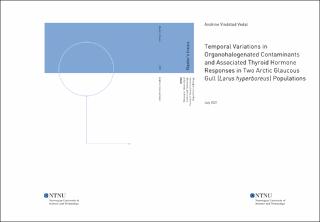| dc.contributor.advisor | Jenssen, Bjørn Munro | |
| dc.contributor.advisor | Gabrielsen, Geir Wing | |
| dc.contributor.advisor | Strøm, Hallvard | |
| dc.contributor.author | Vedal, Andrine Vindstad | |
| dc.date.accessioned | 2021-09-25T16:04:26Z | |
| dc.date.available | 2021-09-25T16:04:26Z | |
| dc.date.issued | 2021 | |
| dc.identifier | no.ntnu:inspera:79539794:15899983 | |
| dc.identifier.uri | https://hdl.handle.net/11250/2782515 | |
| dc.description.abstract | Polyklorerte bifenyler (PCBs), organiske klorerte pesticider (OCPer), og per- og polyfluorerte stoffer (PFASer) er persistente organiske forurensninger (POPer) som finnes i det uberørte Arktis, til tross for at produksjonen av mange av dem er globalt begrenset eller forbudt. Disse organiske halogenerte miljøgiftene (OHCene) har blitt relatert til effekter på organismers tyroidhormon (TH)-homeostase, noe som skaper bekymring med tanke på de potensielle effektene på både individ- og populasjonsnivå. Polarmåken (Larus hyperboreus) er en av toppredatorene i Arktis som akkumulerer høye OHC-nivåer, og populasjonsstørrelsen på Bjørnøya, Svalbard, har gått ned drastisk de siste tiårene. I motsetning har populasjonsstørrelsen i Kongsfjorden, Svalbard, økt og er nå stabil. Målet med dette studiet var å undersøke PCB-, OCP-, og PFAS-konsentrasjoner, og deres effekter på total og fri tyroksin og trijodtyronin (TT4, FT4, TT3, og FT3, respektivt)-konsentrasjoner og -ratio i blodplasma av polarmåker i disse to populasjonene i løpet av 2015 – 2019 perioden. Dette for å vurdere om TH-forstyrrende effekter bidrar til populasjonsnedgangen på Bjørnøya. Polarmåker fra Bjørnøya hadde veldig høye OHC-konsentrasjoner sammenlignet med fuglene fra Kongsfjorden i løpet av femårsperioden. I begge populasjonene hadde hunfuglene lavere OHC-konsentrasjoner enn hanfuglene, noe som indikerer at hunfugler kan kvitte seg med OHCer via overføring av miljøgifter fra mor til egg. Ingen lokalitetsforskjeller ble funnet i noen av TH-konsentrasjonene eller -ratio, og bare FT3-konsentrasjoner og FT4/FT3-ratio var signifikant forskjellig mellom kjønn innad i hver lokalitet. Disse resultatene indikerte at de høye OHC-konsentrasjonene ikke påvirket TH-nivåene i disse fuglene. Prinsipal komponent analyser (PCAer) som inkluderte begge lokaliteter støttet dette funnet, mens lineære blandet-effekt modeller (LMMer) indikerte positive effekter av PFASer på TH-konsentrasjoner, men ikke på TH-ratio, på tvers av de to populasjonene. Lokalitet, prøvetakingsår, kjønn, kroppskondisjonsindeks (BCI), og lipidvektprosent i plasma var andre variabler som bidro i variasjonen i TH-nivåene. Ingen effekt av PCBer og OCPer ble funnet. Resultatene av dette studiet foreslår at disse polarmåkene ikke har blitt signifikant påvirket av TH-forstyrrende effekter forårsaket av eksponering for forurensning, og at TH-forstyrrende effekter trolig ikke bidrar i populasjonsnedgangen på Bjørnøya. Derimot så er TH-nivåene regulert av tyroidstimulerende hormon (TSH), og det bør ikke utelukkes at fuglene kunne opprettholde relativt konstante TH-nivåer til tross for den mulige TH-forstyrrende effekten av PFASer. Det bør understrekes at prøver ble tatt fra hekkende, og dermed relativt friske individer. Fremtidige studier burde derfor vurdere å inkludere individer i tidligere livsstadier og ikke-hekkende individer for å kunne utelukke at prøvetakingen er forutinntatt, analogt til «Healthy Worker Effect» fenomenet (HWE; sunne arbeider-effekten). | |
| dc.description.abstract | Polychlorinated biphenyls (PCBs), organochlorinated pesticides (OCPs), and per- and polyfluoralkyl substances (PFASs) are persistent organic pollutants (POPs) found in the pristine Arctic, despite many of them being globally restricted or banned. These organohalogenated contaminants (OHCs) have been related to effects on the thyroid hormone (TH) homeostasis in organisms, causing concern of their potential effects on both individual and population level. The glaucous gull (Larus hyperboreus) is one of the top predators in the Arctic accumulating high OHC levels, and the population size on Bjørnøya, Svalbard, has decreased drastically during the past decades. In contrast, the population size in Kongsfjorden, Svalbard, has increased and is now stable. To assess whether TH disruptive effects could have contributed to the population decline on Bjørnøya, the present study aimed to investigate the PCB, OCP, and PFAS concentrations, and their effects on the total and free thyroxine and triiodothyronine (TT4, FT4, TT3, and FT3, respectively) concentrations and ratios in blood plasma of glaucous gulls in these two populations during the 2015 – 2019 period. Glaucous gulls from Bjørnøya had very high OHC concentrations compared to the birds from Kongsfjorden throughout the five-year period. In both populations, female birds had lower OHC concentrations compared to males, indicating that females can get rid of OHCs through maternal transfer of contaminants to the eggs. No differences in neither of the TH concentrations nor ratios were observed between locations, and only FT3 concentrations and FT4/FT3 ratios differed between sexes in both locations. These results indicated that the high OHC concentrations did not alter the TH levels in these birds. Principal component analyses (PCAs) including both locations supported these findings, while linear mixed-effect models (LMMs) indicated positive effects of PFASs on the TH concentrations, but not on the TH ratios, across the two populations. Other variables that contributed to the variation in the TH concentrations were location, sampling year, sex, body condition index (BCI), and plasma lipid weight percentage. No effects of PCBs and OCPs were found. The results from the present study suggest that these glaucous gulls do not experience significant TH disruptive effects caused by pollutant exposure, and that TH disruptive effects are most likely not contributing to the population decline on Bjørnøya. However, the TH levels are regulated by the thyroid stimulating hormone (TSH), and it cannot be disregarded that the birds were able to maintain relatively constant TH levels despite of the possible TH disruptive effect of PFASs. It should be emphasised that samples were obtained from breeding, and thereby relatively healthy individuals. To be able to rule out biased sampling, analogous to the Healthy Worker Effect (HWE) phenomenon, future studies should consider including early life-stage and non-breeding individuals. | |
| dc.language | eng | |
| dc.publisher | NTNU | |
| dc.title | Temporal Variations in Organohalogenated Contaminants and Associated Thyroid Hormone Responses in Two Arctic Glaucous Gull (Larus hyperboreus) Populations | |
| dc.type | Master thesis | |
